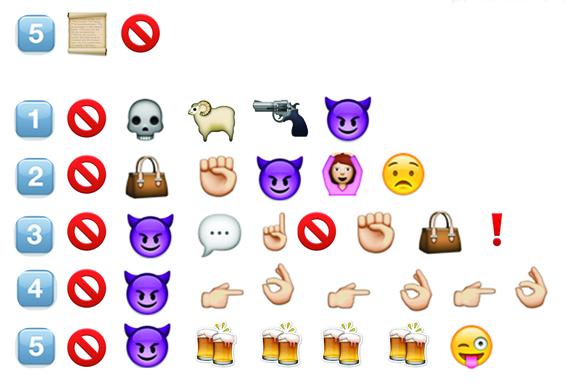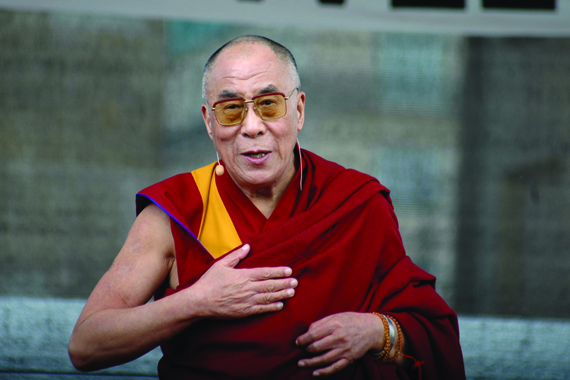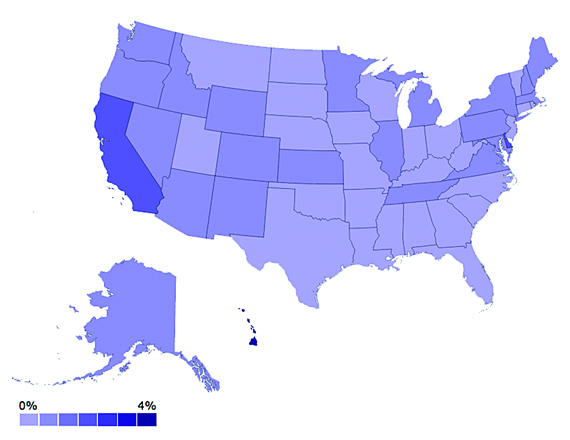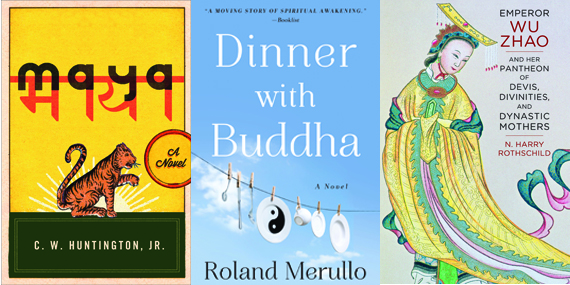
If the Buddha Had an iPhone
Emojis—the little icons available on text messaging keyboards—transmit not only the agonies and ecstasies of millennial micro-drama but also, it turns out, the ageless teachings of the Buddha. Take a whirl and see how many of the five precepts you can identify in the picture above. Answers: (1) Abstain from killing. (2) Abstain from stealing. (3) Abstain from false speech. (4) Abstain from sexual misconduct. (5) Abstain from the abuse of intoxicants.

Pop
Sitting next to the infamous Late Show desk, the rock singer and actress Courtney Love went where no star in that chair has gone before: she put her palms together and chanted “Nam-myoho-renge-kyo.” She had just explained how her Nichiren Buddhist practice, with its twice-daily meditation ritual, had rescued her from drug addiction. “You meditate, right?” she then asked host David Letterman. “Yes,” he replied. “But I get bored.”

Celebrations
The Dalai Lama doesn’t mean to brag, but he’s made it to 80! Well, almost. On July 6 he’ll be celebrating at the University of California, Irvine, at a compassion summit to be held in his honor. If his unrelenting international flight itinerary and irrepressibly radiant demeanor are any indication, His Holiness should have at least another 80 left in him. Precocious toddlers of Tibet, don’t eye the throne yet. (See Tricycle’s own celebration.)

Public Religion Research Institute, American Values Atlas, 2014https://ava.publicreligion.org
Last But Not Least
Hawaii is the big winner here. Too often omitted from conversations about the hubs of American Buddhism, the state appears front and center on this map, directly below the Texas–New Mexico border, in a geographically inaccurate yet poetically just restoration of its status as the state with the highest concentration of Buddhist practitioners. We see you, Hawaii, we really do.
Little Buddhist Schoolhouse
Imagine a 19th-century schoolhouse, but give it a modern-day Buddhist twist: Replace its clapboard walls with vast glass windows that overlook a lush forest; swap its straight-backed chairs for burnt-orange meditation cushions; change the stern headmaster to a top-knotted young man in full lotus. Voilà! What’s left isn’t merely a figment of your imagination; it’s Saraha Children’s School (SCS), a private, state-certified K–8 institution of Buddhist learning in Eugene, Oregon.
Its dharma gates open since August 2014, SCS combines progressive pedagogy and contemplative Buddhism to foster an accepting and supportive environment for each of its five students. The day begins with three prostrations, a short meditation, a mindfulness walk in the school’s wooded backyard, and a classroom session that breaks for a family-style lunch. Then more class time, which includes standard subjects like math and reading, but also religious topics like Tibetan language, dharma, and meditation instruction.
SCS is housed in and affiliated with the Saraha Nyingma Buddhist Institute, a Tibetan Buddhist center founded in 2011. The school’s promotional materials, however, convey a secular flavor: “Buddha’s teachings are not a religious doctrine or cultural tradition; rather they are practical instructions for realizing wisdom, peace, and happiness.” Whether they grow up to be self-identifying Buddhists or not, these children may very well end up kinder and more empathetic as a result of their schooling.
But don’t mistake them for pushovers. “I like that we have a voice,” said Sage, an 11-year-old student, to the Oregon newspaper Eugene Weekly. “Like, if there’s a change to our schedule, we’re involved.” With nature walks and home-cooked lunches, what more could an 11-year-old want?

Books
Using fiction to convey religious principles is an ungainly task, as it rarely does justice to either the artistic aspiration or the spiritual one. But as two forthcoming Buddhist-inspired novels—Dinner with Buddha, by Roland Merullo (Algonquin Books, June 2015), and Maya, by C. W. Huntington, Jr. (Wisdom Publications, June 2015)—show, the genre is perfect for evoking the messy, alternately hilarious and tragic circumstances that arise when people try to live by those principles.
Dinner with Buddha is the latest in a series that follows the unorthodox friendship between Otto Ringling, a defiantly cynical New York book editor, and Volya Rinpoche, a Mongolian monk. Maya, the first novel from C. W. Huntington, an American scholar and professor of Buddhist studies, takes us to India in 1975, where expatriate spiritual seekers put their ideals to the test amid societal turmoil beyond their comprehension.
Over the course of its 5,000-year history, China has had a grand total of one female head of state: Wu Zetian—or, as she was known, Empress Wu. In this exhaustively researched account (Emperor Wu Zhao and Her Pantheon of Devis, Divinities, and Dynastic Mothers, Columbia University Press, June 2015), N. Harry Rothschild, an associate professor of Asian history at the University of Florida, explains how Empress Wu invoked feminine mystical figures of the Confucian, Taoist, and Buddhist traditions to solidify her authenticity, which allowed her to lead China for half a century.